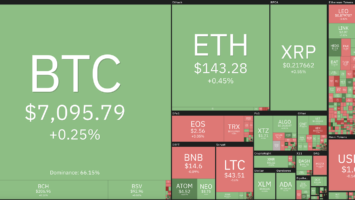Major financial institutions love certainty, and that will help the crypto community immensely. Let’s get down to basics: A stablecoin is a type of digital asset designed to solve the problem of the hypervolatility of cryptocurrencies.
This year is an exciting time for stablecoins as interest among financial institutions picks up speed. For example, Wisdomtree, a regulated money manager, has made plans to launch a stablecoin as an extension of its business in exchange-traded funds. IBM, State Street, JPMorgan Chase and Wells Fargo have all been exploring the opportunities provided by stablecoins. None of these institutions are prone to wild speculation. It’s these institutions that will drive mass adoption.
Stablecoins have seen unprecedented growth in the last couple of months, both in terms of demand and utility. Since Feb. 5, the total issued supply has grown by 69.4%, from $5.68 billion to $9.62 billion, according to the research from The Block. This growth coincides with the global liquidity crunch that started on Feb. 20 due to the COVID-19 pandemic. The panic and instability caused by the pandemic is exposing the weaknesses of both national and international infrastructure, including traditional assets.
As financial institutions in France, China and Russia are either researching or discussing national stablecoins, the international G-7 Working Group on Stablecoins has released a report in partnership with the International Monetary Fund and the Bank for International Settlements investigating the impact of stablecoins. Recognizing some of the current risks and challenges, along with the inherent benefits of stablecoins, it recommends that finance ministries, central banks and standard-setting bodies such as the Committee on Payments and Market Infrastructures work with relevant international organizations to improve the efficiency and inclusiveness of financial services in anticipation of the rising utility of stablecoins.
Similarly, in April of this year, the Financial Stability Board — the coordinating body of the G-20 countries — published a set of recommendations on stablecoins, questioning their relevance as an instrument to protect against speculative fluctuations. Crypto-native financial institutions, such as crypto venture funds, have already implemented stablecoins. Digital financial assets are no longer a fringe idea, and the legacy payments industry is bracing for the mammoth and inevitable disruption brought by stablecoins.
How long will it be before financial institutions outside of crypto get wise to this kind of efficiency?
Advantages of stablecoins
Traditional fiat currencies are full of inefficiencies. Middlemen charge unjustified fees to make slow, inefficient transfers. Unstable economies need a reliable currency, and expatriates need an inexpensive means to send funds back home, among other practical use cases. The digital world hates inefficiency, and solutions are inevitable. Cryptocurrencies are a solution, however with every new technology, there are new problems to solve, and they have suffered from wild and unpredictable swings in value.
A stablecoin has all the advantages of a cryptocurrency: almost instantaneous, inexpensive, borderless, peer-to-peer transfers and available 24 hours per day, seven days per week. But unlike a cryptocurrency, a stablecoin’s value is fixed in relation to a known unit of currency. So, if you send a stablecoin that is worth $10 to a friend, it is almost certainly going to be worth about $10 tomorrow and a month from now. It is therefore not surprising to see that a digital asset that has all of the advantages, and none of the drawbacks, of its competitors would explode in use. For example, the use of the Tether (USDT) — a stablecoin backed by the United States dollar — has spread widely and internationally. More than 9 billion USDT is in circulation for a transaction volume of around $40 billion every 24 hours, according to data from CoinMarketCap at the time of writing.
Yes, the very word “stablecoin” has become a buzzword with the rise of projects such as Libra: a virtual currency developed by Facebook. Libra forced regulatory bodies and public authorities to accelerate their decisionmaking on the subject. With newfound scrutiny came new questions, starting with the usefulness of these tokens and their potential implementation in the traditional currency market.
Stablecoins and financial institutions: New and diversified convergence
Beyond the obvious advantages, stablecoins solve a crucial financial bottleneck in the era of globalization: international monetary transfers. The need for individuals and institutions to transfer funds anywhere in the world, quickly and at low cost, is one that is shared by all players. This triptych of the “mobility, instantaneity and minimal costs” of tokens is now part of the blockchain, a technology that makes these exchanges more efficient, transparent and secure.
Today, a major part of so-called “cross-border” payments — transactions involving individuals, companies or banks operating in at least two different countries — are made by companies to pay their suppliers, subsidiaries or employees. Nevertheless, these transfers are expensive and sometimes outrageous. The fees taken by the giants of the sector specializing in international transfers (remittances) are sometimes between 5% and 10% of each transfer. You might expect that with such high fees, the transfer would at least be convenient for both parties. But in reality, these transfers are painfully slow, sometimes taking up to two working days.
For example, imagine that a global company based in the U.S. seeks to send money to Asia and is quickly confronted with high long-term costs. Its alternatives are limited and most often involve a short-term loan from a bank, customers or suppliers — a solution that is expensive, not very scalable and often risky.
Cut out the middleman. A stablecoin would enable the company to transfer funds quickly, transparently and for practically nothing. The same is true for individuals. Why should someone working for minimum wage have to pay a huge fee just to send money home? Why would anybody pay high fees for a service that is entirely unnecessary? More than ever before, stablecoins appear to be the future of monetary and financial transfers.
Stablecoins and Libra have the potential to grow substantially and shoulder a significant proportion of global transactions. However, JPMorgan estimates that it would take approximately $600 billion of base stablecoin currency to support the flow of $1 trillion in daily transactions without risk of disruption.
Central banks as new bridges between stablecoins and developments in the monetary system
As stablecoins are poised to allow monetary transfers around the globe, a stablecoin issued by a central bank represents the safest monetary value in our system and would replace archaic banknotes. This programmatic dimension makes it practical to automate money remittances securely to millions of people, especially if implemented by governments.
Let’s imagine a simple scenario from just this year. An integration of a stablecoin by the U.S. Federal Reserve would have made the distribution of $1,200 checks to the households hardest hit by the COVID-19 pandemic much faster. Instead, people with no income at all waited sometimes for weeks for physical checks, unable to pay their bills during the pandemic.
The Fed continues to monitor the costs and benefits of issuing a central bank digital currency and has reiterated the notion that some countries may be more suitable than others for a new digital payment service or money. The Fed’s reluctance to take deposits comes down to worries about effects on monetary policy, reducing the role of the commercial banking system and ultimately introducing the potential for systemic stress. As long as the Fed maintains this position, the idea of a CBDC will not take off in the U.S.
But that’s not the situation in Europe.
France is aiming to be a global leader of central-bank-issued digital currencies with a digital euro. Previous concerns coming from both France and Germany, that Facebook’s Libra project posed risks to Europe’s financial sector, have been eased by the development of new regulations to normalize virtual currencies in the eurozone. France has not yet set the details in stone but has invited proposals to explore a CBDC. Up to 10 applications will be funded during this pilot phase. The goals of these tests are to provide a model of a CBDC-based interbank settlement, identify its benefits and analyze its risks. Awards for innovative proposals will be made on July 10. Other countries are testing the waters as well. What is clear from all this government activity is that stablecoins are moving into the mainstream.
The change is already here
Just as the instability caused by COVID-19 has sent traditional assets to the stable U.S. dollar, cryptocurrencies have sought safe haven in stablecoins. The fast pace of digitization is only accelerating and the world will not be the same after this.
Stable corners in the otherwise chaotic digital asset space are a perfect symbol of the revolution that payment systems are facing today. This step marks a major evolution of our monetary system and lays the foundations for a new logic of our financial workings: open, transparent and accessible to all. As an article written by Angela Strange and published by Andreessen Horowitz — one of the world’s most recognized venture capital funds — points out: “Every Company Will Be a Fintech Company.” The change is already here.
The views, thoughts and opinions expressed here are the author’s alone and do not necessarily reflect or represent the views and opinions of Cointelegraph.
Hugo Renaudin is the CEO of LGO, a digital asset exchange designed for institutional investors. Prior to this, Hugo worked in various roles within the financial industry. This included positions in FX trading, equity derivatives and fund management. His first venture into cryptocurrency began at BitSpread, where he was a portfolio advisor. Hugo holds a Master of Science from Columbia University and a Master of Science from Ecole Polytechnique in France.




Comments (No)